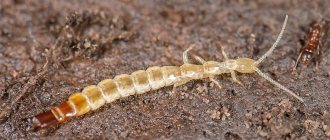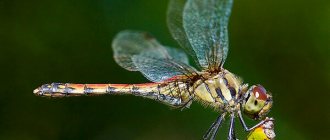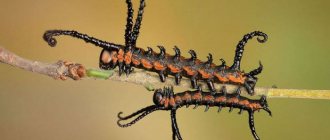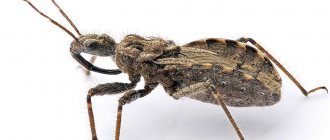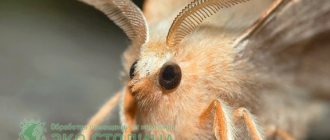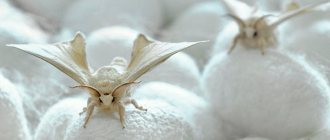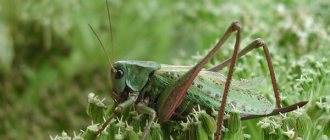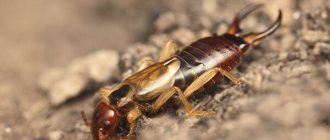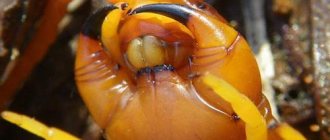Small, slippery, fast-moving and seemingly menacingly clicking with their “pincers”, earwigs always jump out of some dark place when we least expect it. This behavior of these relatively harmless insects makes us think first of all about how best to get rid of them.
In addition, there is a strong rumor among the people - after all, it is not without reason that earwigs are called that way - they penetrate the ears of sleeping people, more often children, imperceptibly sneak into the brain, lay eggs, and the hatched larvae begin to actively eat the gray matter. As a result, the person goes crazy, and no one can determine the cause of this strange phenomenon.
Why are two-tailed earwigs called earwigs?
Before answering this question, we should immediately clarify that it would be more correct to ask - why were earwigs called two-tailed? Of course, for their peculiar tail part of the body, which is represented by two “branches” of pincers with sharp ends. This tool is necessary for insects to defend themselves from enemies or to hold larger prey.
The specific shape of this organ gave rise to the second name of the earwig among the Russian-speaking population - two-tailed. In fact, the two-tailed insect is a completely separate genus of insects, many species of which are now classified as fossils.
The name "earwig" comes from a myth that the insect can enter a person's ear and settle there, laying eggs and feeding on the brain. Although such data are indeed considered myths, such an entomological name when translated from different languages of the world is translated in the same way as the meaning in Russian, which is quite unique for the names of insects.
So, two-tailed ones are not earwigs, but due to common usage we will sometimes call them that. They are earwigs because they are believed to be able to get into ears. Let's take a closer look at whether this is true.
Appearance of an earwig
The earwig has a flattened, elongated body. The back color is chestnut brown, the belly color is dark brown. The head is heart-shaped. The antennae on the head consist of 11-14 segments, their length is 2/3 of the length of the body. The eyes are very small. The forewings are short, without veins. The hind wings are membranous, wide, and veined.
During flight, the earwig's body is almost vertical. When the wings are folded, they are tucked under the elytra twice. Earwigs fly extremely rarely, but prefer to use their limbs. The length of females ranges from 12-14 millimeters, and males - 13-17 millimeters.
A notable feature of the earwig is its forked “tail.”
A characteristic feature of earwigs is a pair of pincers on the tip of the body. Both sexes have these forceps, but in males they are larger, have teeth, and are rounded on the inside. In females they are smooth and straight. Earwigs use these pincers to protect and hold prey. If you reach out with your hand towards an earwig, it will raise the back of its body and expose its weapon. With these pincers, she can pierce the skin into blood. But they do not attack people, and sting only during defense.
Can a double tail crawl into your ear?
To answer your question, you need to know how doubletails reproduce. In order to impregnate a male, the male captures her and holds her with his pincers, injecting his seed into her genitals. Eggs that have already formed in the female's genitals may not be fertilized immediately - the seed can be safely stored in the female's genitals for several months and only then eventually complete its main task of fertilization.
To lay eggs, the female earwig spends a very long time looking for a suitable place for this purpose. Conditions that are guaranteed to be necessary for this include darkness, optimal humidity levels and proximity to a food source. Female earwigs, like no other insects, are very caring about their offspring, which is very rare in the world of insects.
After hatching, young earwigs develop in a series of five molts, increasing in size each time. The mother earwig, unlike most non-social insects, actually protects her young, at least until it begins to make its first attempts to leave the nest, which is observed only after 2-3 molts. But even after this, mothers seriously care for their children, first of all protecting them from enemies.
While people may have long associated this insect with its tendency to crawl into ears, in reality this almost never happens.
However, this is still possible, but even if it happens, then in the space of the external auditory canal of a person there are no necessary conditions for laying eggs. Besides everything else, if we talk about the fact that an insect unnoticedly drills passages to the brain, then this cannot be discussed at all, since the presence of a foreign body, especially a living one, cannot pass unnoticed by a person.
Here is one of the stories with this insect:
“At 3 a.m., my 8-year-old daughter woke me up from a deep sleep. She was very upset. During the previous few minutes, she had attempted to independently remove “some living thing” that was crawling in her left ear canal. After that we became hysterical and went to the hospital. Otoscopic examination revealed the presence of a dark brown mass near the eardrum. The beginning of my brief lecture with my daughter about the importance of proper ear hygiene was interrupted when the doctor noticed movement. Upon closer examination, he was able to extract an insect about 2 cm long, which was an earwig.”
Although this story does not seem too plausible, it is quite true. Without focusing specifically on the earwig, there are many anecdotal stories, some of which are even well documented, that speak of various insects being found in people's ears. Why not, actually.
All insects that live mainly in narrow long burrows may well be interested in the external auditory canal of a person if they gain access to him. However, they will not finally settle there, much less have offspring, also because the temperature of the human body is quite high for such living organisms. Even lice, after a bite, tend to move higher to the spine of a human hair, since the scalp is “too hot” for them.
Why is an earwig dangerous for humans?
Earwigs move quite quickly due to their many short legs and fairly flexible body. They go out hunting at night, crawling out of their hiding places. Under certain conditions, this arthropod can bite. As a rule, this does not cause severe pain in an adult. If an earwig bites a child, the child's reaction may be violent.
Particular attention should be paid to the presence of people prone to allergies in the apartment. In addition, an infection can enter the human body through the wound if the wound is not treated in time.
If, nevertheless, the two-tailed fish managed to bite a person, then:
- Firstly, there is no need to panic as this is a simple bite and completely harmless. She does not inject any toxins into the wound.
- The bite site should be immediately treated with alcohol or vinegar.
- To prevent allergic reactions, it is better to take antihistamines such as Cetrin, Suprastin, Diazolin or Cloritin. Alternatively, the bite area can be anointed with Fenistil-gel.
- It is better to cover the bitten area with a clean cloth, such as a handkerchief. It is better not to glue anything on the wound, so as not to create a greenhouse effect.
If you complete all the procedures on time and use the right medications, then the likelihood of allergic reactions is reduced to zero.
What to do if a double-tail has crawled into your ear
In any case, if something bothers you in your ear, you should consult a doctor without trying to influence the cause of the trouble yourself. After all, this can only do harm. If the pain cannot be tolerated until the morning, you can safely call an ambulance. As for earwigs or other insects that accidentally entered the external auditory canal, you cannot disturb them there unless you want to get a defensive response, which can be quite painful.
There is no need to be afraid that the insect will be able to penetrate somewhere deep into the skull. The external auditory canal on that side ends with an auditory membrane, which hermetically seals the canal along its entire diameter. As for the brain, it is generally additionally protected by bone plates, which cannot be pierced or gnawed by any known insect that, by coincidence, may end up there.
If it is not possible to urgently go to a medical facility, but it is known for sure that there is an insect in the ear, you can resort to the following actions to remove it from there:
- If a double-tail has crawled into your ear, you should not fiddle with different objects in the ear canal, even with your finger. By poking an insect you can encourage it to bite or sting. In the case of an earwig, a pinch with pincers is guaranteed. In addition, a living creature inside the ear can simply be killed, and it is then more difficult to remove its remains in parts than as a whole and alive. Believe me, it has already realized that it is uncomfortable there and it itself will strive to get out of there.
- Place the victim's head on its side, with the affected ear facing up.
- Pray to your higher power that the insect will crawl out of there on its own legs. If this does not happen, proceed to the third step.
- You need to drip a few drops of vegetable oil into your ear, preferably olive oil, by pulling the lobe. For children, the lobe should be pulled back and down, for adults - back and up. I would like to hope that the insect will drown there. After some time, the oil needs to be removed; this can be done by rinsing with water from a large syringe.
Why is an earwig dangerous for humans?
Many people are puzzled by the question of whether earwigs are dangerous to humans. After all, the myth about the ability of an insect to get into a person’s ears makes us think.
If such a situation does occur, it is necessary to drop a few drops of hydrogen peroxide or vegetable oil into the ear. After which they shine a flashlight into the ear, allowing the insect to crawl out into the light. If there is no result, consultation with a specialist is necessary. However, there is no need to worry about this - such cases are quite rare and do not occur more often than with other insects.
The fact that earwigs bite is a proven fact. The substance secreted by insects has a specific odor, but is not poisonous. Its biting pincers are released during defense, trying in this way to scare away its opponent. They bite using claws, but it doesn't hurt very much. Children who have more delicate skin usually feel pain when bitten.
Symptoms of an earwig bite in a person suffering from allergies may include the following:
- the presence of redness on the skin;
- swelling and swelling around the injury site;
- the appearance of blisters resembling herpes.
Below is a photo of an earwig bite.
Earwig bite
What do twin tails eat?
Earwigs go out in search of food mainly at night. They love decaying organic matter, such as the remains of dead leaves or insects, and are also natural predators of many other insects, including mites and aphids. Omnivorous. In some cases, young shoots of indoor plants can be attacked, mainly seedlings that simple summer residents like to grow on their windowsills. The soft, ripe and juicy pulp of strawberries, raspberries, peaches, cherries is also to the taste of these cute creatures.
The largest double tail in the world
Today, official entomology confirms that all known species of earwigs are approximately the same size - from 1 to 3 cm, depending on the stage of the sexual cycle and the species. There are slightly larger individuals, but their length does not exceed the standard by 1-1.5 cm.
But our planet also knows larger specimens of earwigs, reaching almost 8 cm in size.
This is not a separate species that is extinct today, it is an ordinary earwig, but its size was associated with such a concept as island gigantism. The first such large specimen was found in 1798 on the island of St. Helena, where, by the way, Napoleon was exiled. In that small area of land there were no natural predators of earwigs, which allowed them to grow to such limits.
Controlling earwigs in the garden
Prevention The most important part of controlling earwigs is removing their hiding places so that there is not too much plant debris, boards, downed tree trunks, or anything else left in the area that could serve as a hiding place for them.
If earwigs have already taken a fancy to your garden, try the following remedies:
- Place approximately 20cm long pieces of garden hose in the beds between the plants. Check these traps every morning and shake out the earwigs in a bucket of soapy water.
- To protect large plants, apply petroleum jelly to their stems to prevent earwigs from crawling on it.
- If insects have infested your woodpile, try spraying it with a borax solution, but keep pets and children away from the area afterwards.
- Oil pit traps are also an excellent remedy for earwigs. Mix equal parts soy sauce and vegetable oil in a small plastic container and cover with a lid. Punch holes in the top of the container near the lid to allow earwigs to enter. Bury the container in the soil to the level of the holes. The soy sauce will attract the earwigs, but the oil will keep them from getting out. Change the mixture periodically to a new one.
- Alcohol can penetrate the waxy layer of the insect's integument and kill it upon direct contact with the body. To make an insecticidal spray, mix equal parts 70 percent alcohol and water (or, if using 95 percent alcohol, mix 1 part alcohol to 1 ½ parts water).
- Earwigs are also susceptible to diatomaceous earth (diatomaceous earth is available at garden centers), so you can protect your plants by spreading a ring of powder around the bushes if the soil is dry enough. Diatomaceous earth is not effective in wet weather.
Why are double tails harmful?
In conclusion, I would like to briefly list the main “harmful” qualities of two-easters:
- They evoke fear in people and a rather disgusting sensation due to their unsightly red-brown color, elongated shape, nocturnal lifestyle, the myth associated with their activity in the ear canal, and, of course, their sharp cerci.
- A large number of two-wests that suddenly appeared in a living room indicate increased humidity somewhere nearby. A pipe may have burst or there may be a leak on the roof. Although this indicator does more good than harm, informing about the problem of dampness in time.
- By attacking young plants, earwigs spoil carefully grown seedlings and seedlings in open ground.
- They can pinch you with their churches. This “bite” rarely damages the skin and does not contain poison.
Actually, this is where the disadvantages of these insects end. They're not as scary as they are described, right? Take care of wildlife, good luck in all your endeavors!
Earwig: where does it live?
The life of an earwig always takes place in conditions where the following 4 factors are necessarily combined:
- Dark.
- Damp.
- Warm.
- Secluded.
She looks for them in any place where she appears. In nature you can stumble upon it:
- In the curled leaves of plants
- Closed for the night and withered flowers
- In the fallen leaves
- Under the bark of the trees
- In wood stacks
- Under the stones
- Under folded boards or roofing felt
- In the cracks of the house foundation
Earwigs prefer to build nests and lay eggs in earthen burrows in the upper layers of the soil.
There they spend the entire winter, protecting their offspring until spring. If an earwig has settled in an apartment or house, you need to find out where it lives and whether the nest is located on the territory of the house or whether its appearance is just an accident. In a person’s home, comfortable living conditions for insects are created:
- In cracks in walls and ceilings
- Under the bath
- Under the sink
- In the kitchen
- In damp textiles
- In the cracks in the floor
- Behind baseboards and door jambs
If you see earwigs regularly, then most likely they live in an apartment or house. In this case, it is necessary to urgently take measures to destroy them, before the parasites have time to multiply excessively and fill the entire house.
